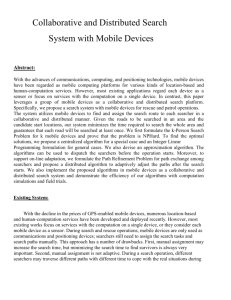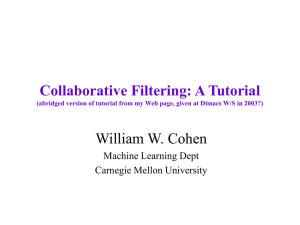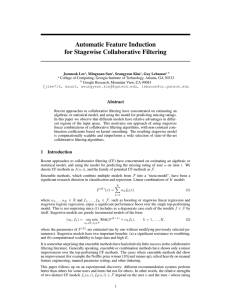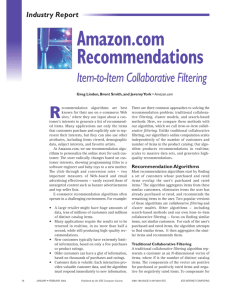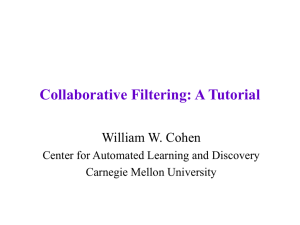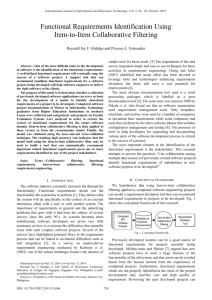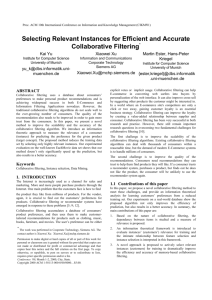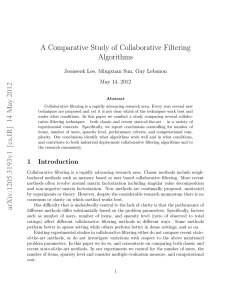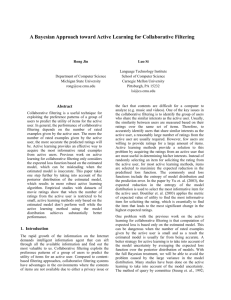COMP 621U Project Proposal
advertisement
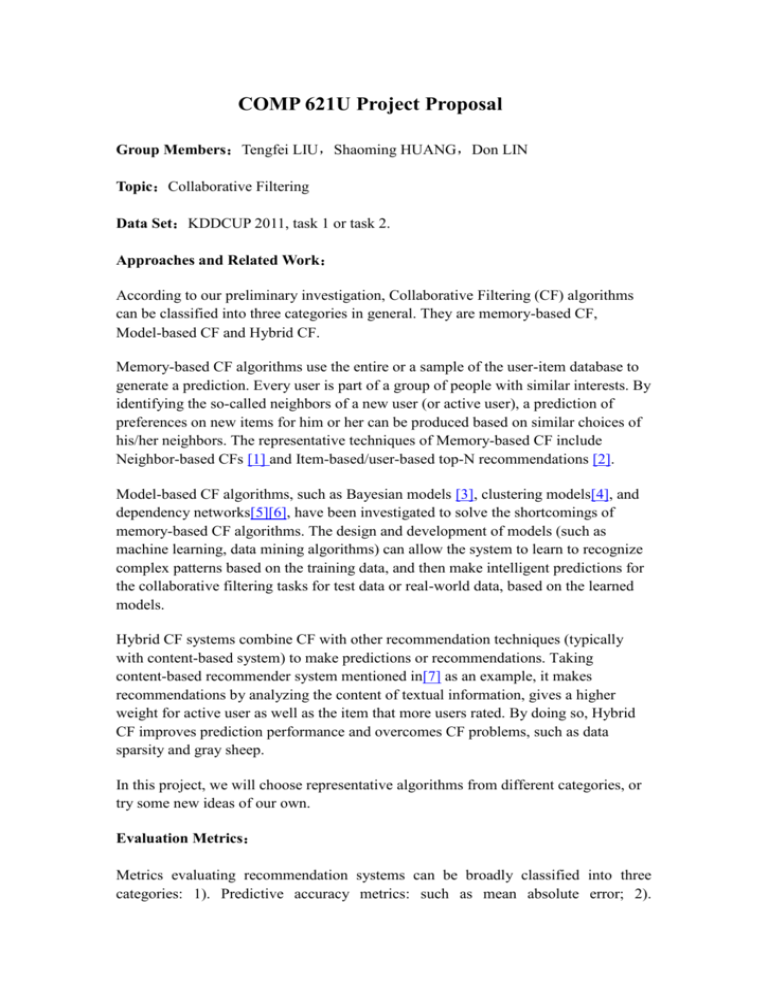
COMP 621U Project Proposal Group Members:Tengfei LIU,Shaoming HUANG,Don LIN Topic:Collaborative Filtering Data Set:KDDCUP 2011, task 1 or task 2. Approaches and Related Work: According to our preliminary investigation, Collaborative Filtering (CF) algorithms can be classified into three categories in general. They are memory-based CF, Model-based CF and Hybrid CF. Memory-based CF algorithms use the entire or a sample of the user-item database to generate a prediction. Every user is part of a group of people with similar interests. By identifying the so-called neighbors of a new user (or active user), a prediction of preferences on new items for him or her can be produced based on similar choices of his/her neighbors. The representative techniques of Memory-based CF include Neighbor-based CFs [1] and Item-based/user-based top-N recommendations [2]. Model-based CF algorithms, such as Bayesian models [3], clustering models[4], and dependency networks[5][6], have been investigated to solve the shortcomings of memory-based CF algorithms. The design and development of models (such as machine learning, data mining algorithms) can allow the system to learn to recognize complex patterns based on the training data, and then make intelligent predictions for the collaborative filtering tasks for test data or real-world data, based on the learned models. Hybrid CF systems combine CF with other recommendation techniques (typically with content-based system) to make predictions or recommendations. Taking content-based recommender system mentioned in[7] as an example, it makes recommendations by analyzing the content of textual information, gives a higher weight for active user as well as the item that more users rated. By doing so, Hybrid CF improves prediction performance and overcomes CF problems, such as data sparsity and gray sheep. In this project, we will choose representative algorithms from different categories, or try some new ideas of our own. Evaluation Metrics: Metrics evaluating recommendation systems can be broadly classified into three categories: 1). Predictive accuracy metrics: such as mean absolute error; 2). Classification accuracy metrics: such as precision, recall, F1-measure; 3).Rank accuracy metrics: Pearson’s product-moment correlation, Mean average precision. Our final choice will depend on the specific task. Reference 1. M. R. McLaughlin and J. L. Herlocker, “A collaborative filtering algorithm 2. 3. 4. 5. 6. 7. and evaluation metric that accurately model the user experience,” in Proceedings of 27th Annual International ACM SIGIR Conference on Research and Development in Information Retrieval (SIGIR ’04), pp. 329–336, Sheffield, UK, 2004. M. Deshpande and G. Karypis, “Item-based top-N recommendation algorithms,” ACM Transactions on Information Systems, vol. 22, no. 1, pp. 143–177, 2004. K. Miyahara and M. J. Pazzani, “Improvement of collaborative filtering with the simple Bayesian classifier,” Information Processing Society of Japan, vol. 43, no. 11, 2002. X. Su, M. Kubat, M. A. Tapia, and C. Hu, “Query size estimation using clustering techniques,” in Proceedings of the 17th International Conference on Tools with Artificial Intelligence (ICTAI ’05), pp. 185–189, Hong Kong, November 2005. D. Heckerman, D. M. Chickering, C. Meek, R. Rounthwaite, and C. Kadie, “Dependency networks for inference, collaborative filtering, and data visualization,” Journal of Machine Learning Research, vol. 1, no. 1, pp. 49–75, 2001. D. Nikovski and V. Kulev, “Induction of compact decision trees for personalized recommendation,” in Proceedings of the ACM Symposium on Applied Computing, vol. 1, pp. 575–581, Dijon, France, April 2006. P. Melville, R. J. Mooney, and R. Nagarajan, “Contentboosted collaborative filtering for improved recommendations,” in Proceedings of the 18th National Conference on Artificial Intelligence (AAAI ’02), pp. 187–192, Edmonton, Canada, 2002.



